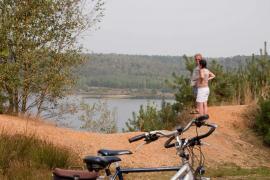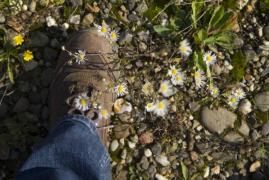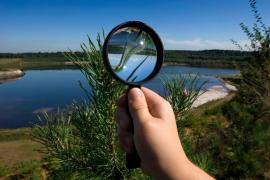A dip in time reveals that the Hoge Kempen National Park has a long history...
1912
Since the beginning of the twentieth century the Hoge Kempen has been the object of many initiatives. Prof. Massart, in his reference work 'Pour la protection de la Nature en Belgique' (1912), pays ample attention to the Hoge Kempen and advocates the realisation of a large 'nature park'.
1938
The first explicit mention of this idea can be deduced from a newspaper article from 1938, albeit as a result of political resistance to this idea, put forward from Brussels: 'We fully agree on the beauty and pleasantness of a large-scale nature reserve (...), but cannot imagine that, by limiting the growth of our industrial area, a path is being followed which is advantageous to Limburg' (Anonymous, 1938).
During the German occupation, an initial step towards a spatial structure plan for Limburg was made (Verwilghen & Soetewey, 1942). Here, too, there is talk of a 'Nature Reserve' on the eastern edge of the Kempen Plateau.
1966
Because of the administrative and economic chaos following the end of the Second World War, it was not until 1966 that a new initiative was taken to draw attention to the irreplaceable natural values. In Limburg, a Commissie voor Natuurparken en Toeristische Recreatieoorden is established. The book Groen in Limburg (Green in Limburg, 1971) gives the results of the work of this committee and introduces the 'nature parks'. Eight more or less coherent areas are defined, including the 120 km² 'Park van de Hoge Kempen'. The most tangible result of this well-intentioned initiative was the construction of so-called 'Tourist Roads', such as through the Mechelse Heide.
In the same period, Mark Roskams of the then Administration of Waters and Forests (the present Nature & Forest Agency) took the initiative to establish 'state nature reserves', with the ambition of preserving the last large moors in Limburg. In record time, the state nature reserves Mechelse Heide, De Teut, Ten Haagdorenheide, Neerharenheide, Ven onder de Berg and Heiderbos (together more than 1 500 ha) are created. His colleague Norbert Martens made similar efforts north of the Bosbeek around the Turfven and Ruiterskuilen and the Oudsberg shifting sands. Terrain management associations such as Orchis, Stichting Limburgs Landschap (the present-day Limburg Landscape Foundation) and Natuurreservaten (the present-day Natuurpunt) are no longer taking a wait-and-see approach and are acquiring land with the aim of setting up nature reserves.
However, none of this can prevent major interventions at the expense of nature: the construction of the E314 and the extraction of sand and gravel over hundreds of hectares are not stopped.
At the end of the 1980s, another threat is added: in an atmosphere of economic crisis and the closure of the Limburg coal mines, there is the plan to build a bungalow park in the so-called Prinsenpark, near the Mechelse Heide and the Ven onder de Berg. Also around Bergerven similar plans see the light of day and the Fenix project in Genk (Klaverberg) would swallow up important forest and heathland areas of the Hoge Kempen.
This is what prompted local action groups and the non-profit organisation Natuurreservaten (currently Natuurpunt) to work out a socially acceptable alternative. Ideas were sought in the Veluwe (Netherlands, Gelderland Province), where there was already a tradition of nature-oriented tourism.
1990
The vague ideas about a nature park, a national park or a landscape park were made concrete in 1990 by the foundation of the non-profit organisation Regionaal Landschap Hoge Kempen (shortly afterwards transformed into vzw Regionaal Landschap Kempen & Maasland).
1998
Although the Regionaal Landschap wants to develop the region of Hoge Kempen and Maasland as the region in Flanders for nature conservation, landscape care and nature tourism, the idea of a large contiguous nature reserve is never far away. In 1998, the idea was seized upon with the launch of the campaign 'Hoge Kempen, Groene Kans' (High Campine, Green Opportunity), asking for support for the establishment of a national park in the High Campine region. Thanks to the echo in the media and the public and political support for this idea, the policy groups of the Limburg Plan ask Governor Hilde Houben-Bertrand to ask the Flemish Government for an initiative on the matter.
2000
In 2000, the Flemish Government commissioned the non-profit organisation Regionaal Landschap Kempen & Maasland to draw up a 'Master Plan' in close consultation with the 6 municipalities involved, the provincial authorities and the competent administrations.
On 19 July 2002, at the proposal of Vera Dua, Flemish Minister for the Environment, and Renaat Landuyt, Flemish Minister for Tourism, the Flemish Government decided to create the Hoge Kempen National Park on the basis of a widely supported Master Plan. In order to initiate and coordinate the realisation of this plan and to carry out the joint actions, the project office Hoge Kempen National Park was founded by the non-profit organisation Regionaal Landschap Kempen & Maasland. Flemish Minister for the Environment Ludo Sannen becomes the first chairman of the steering committee.
2006
Although the realisation of the National Park would still take years and permanent monitoring and management would always be needed, in the beginning of 2006 the partners involved judge that the conditions are sufficient to be able to speak of a National Park with reason.
On 23 March 2006, in the presence of the Flemish Minister for the Environment Kris Peeters and the then European Commissioner for the Environment Stavros Dimas, the official opening took place of the first national park in Belgium, that of the Hoge Kempen.
2016
On the tenth anniversary of the opening of the Hoge Kempen National Park, the Flemish Minister for the Environment Joke Schauvliege challenges the region to make the National Park "twice as BIG, twice as STRONG and twice as BEAUTIFUL".
2020
After an intensive process of more than two years of consultation, fine-tuning and deliberation, this resulted in the "MASTERPLAN 20-40" at the end of 2019. Under the chairmanship of Flemish Minister for Environment and Tourism Zuhal Demir, the Steering Committee of an enlarged, 32-member 'National Park Coalition' was installed on 31 January 2020.
The number of municipalities directly involved rises from the original 6 to 10, the surface area from about 6000 ha to 12 000 ha, the number of gateways from 6 to 9 and the nature associations Natuurpunt, Limburgs Landschap and Orchis join the coalition as core partners.
The National Park Bureau is expanded and strengthened thanks to the long-term financial commitments of the coalition partners and the collapse of the Dune Belt Project Office.
Also in 2020, the National Park Coalition launches a "20-25 Partner Plan" with an "Operational Programme" for the first five-year planning period. The partners commit themselves to carry out 150 concrete actions with a total investment volume of 118 million Euros.
2021
In execution of the Flemish Governmental agreement, the Flemish ministers Zuhal Demir (Environment, Tourism) and Matthias Diependaele (Heritage) launch the call for candidates for Landscape and National Parks on 19 April 2021 in the Hoge Kempen National Park, with the ambition to recognise 3 additional National Parks.




